Showing Spotlights 1865 - 1872 of 2783 in category All (newest first):
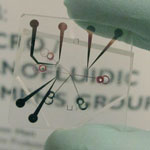 Freshwater could become the oil of the 21st century - scarce, expensive and fought over. While over 70 per cent of the Earth's surface is covered by water, most of it is unusable for human consumption. Technological advances have made desalination and demineralization feasible - albeit expensive - solutions for increasing the world's supply of freshwater. However, nanotechnology- based water purification devices have the potential to transform the field of desalination. Researchers have now demonstrated a new, efficient and fouling-free desalination process based on the ion concentration polarization (ICP) phenomenon - a fundamental electrochemical transport phenomenon that occurs when an ion current is passed through ion-selective membranes - for direct desalination of sea water.
Freshwater could become the oil of the 21st century - scarce, expensive and fought over. While over 70 per cent of the Earth's surface is covered by water, most of it is unusable for human consumption. Technological advances have made desalination and demineralization feasible - albeit expensive - solutions for increasing the world's supply of freshwater. However, nanotechnology- based water purification devices have the potential to transform the field of desalination. Researchers have now demonstrated a new, efficient and fouling-free desalination process based on the ion concentration polarization (ICP) phenomenon - a fundamental electrochemical transport phenomenon that occurs when an ion current is passed through ion-selective membranes - for direct desalination of sea water.
Mar 22nd, 2010
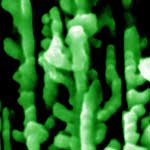 Materials that can produce electricity are at the core of piezoelectric research and the vision of self-powering machines and devices. With the emergence of nanotechnology and the use of nanomaterials, the field of piezoelectrics and nanopiezotronics has experienced a lot of new and interesting research efforts. A recent study, for instance, has demonstrated that the small vibrational energy waste generated in the environment from noise, wind power, running water, or water wave action can be scavenged or harvested as a driving force for direct water splitting. The researchers propose a new piezoelectrochemical mechanism for the direct conversion of mechanical energy to chemical energy and subsequently the splitting of water into hydrogen and oxygen.
Materials that can produce electricity are at the core of piezoelectric research and the vision of self-powering machines and devices. With the emergence of nanotechnology and the use of nanomaterials, the field of piezoelectrics and nanopiezotronics has experienced a lot of new and interesting research efforts. A recent study, for instance, has demonstrated that the small vibrational energy waste generated in the environment from noise, wind power, running water, or water wave action can be scavenged or harvested as a driving force for direct water splitting. The researchers propose a new piezoelectrochemical mechanism for the direct conversion of mechanical energy to chemical energy and subsequently the splitting of water into hydrogen and oxygen.
Mar 19th, 2010
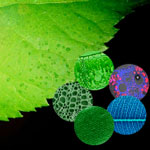 Artificial photosynthesis can offer a clean and portable source of energy supply as durable as the sunlight. Using sunlight to split water molecules and form hydrogen fuel is one of the most promising tactics for kicking our carbon habit. Of the possible methods, nature provides the blueprint for converting solar energy in the form of chemical fuels. A natural leaf is a synergy of the elaborated structures and functional components to produce a highly complex machinery for photosynthesis in which light harvesting, photoinduced charge separation, and catalysis modules combined to capture solar energy and split water into oxygen and hydrogen efficiently. Chinese researchers have now demonstrated the design of an efficient, cost-effective artificial system to mimic photosynthesis by copying the elaborate architectures of green leaves, replacing the natural photosynthetic pigments with man-made catalysts and thereby realizing water splitting- a major advance in energy conversion.
Artificial photosynthesis can offer a clean and portable source of energy supply as durable as the sunlight. Using sunlight to split water molecules and form hydrogen fuel is one of the most promising tactics for kicking our carbon habit. Of the possible methods, nature provides the blueprint for converting solar energy in the form of chemical fuels. A natural leaf is a synergy of the elaborated structures and functional components to produce a highly complex machinery for photosynthesis in which light harvesting, photoinduced charge separation, and catalysis modules combined to capture solar energy and split water into oxygen and hydrogen efficiently. Chinese researchers have now demonstrated the design of an efficient, cost-effective artificial system to mimic photosynthesis by copying the elaborate architectures of green leaves, replacing the natural photosynthetic pigments with man-made catalysts and thereby realizing water splitting- a major advance in energy conversion.
Mar 18th, 2010
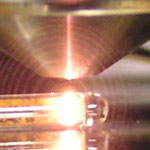 It has been known for several years that carbon nanotubes would heat, ignite and luminesce upon exposure to certain types of electromagnetic radiation, including laser light. However, no one expected any form of fullerenes to do the same thing. Until now. A team at the University of Florida has discovered that functionalized fullerenes heat, ignite, glow and transform into other carbon nanostructures such as carbon nanotubes upon exposure to low-intensity laser light. This is the first time these findings have been published. A possible explanation for the optical heating and ignition phenomena that have been observed is a distortion of the symmetrical cage structure of the fullerenes.
It has been known for several years that carbon nanotubes would heat, ignite and luminesce upon exposure to certain types of electromagnetic radiation, including laser light. However, no one expected any form of fullerenes to do the same thing. Until now. A team at the University of Florida has discovered that functionalized fullerenes heat, ignite, glow and transform into other carbon nanostructures such as carbon nanotubes upon exposure to low-intensity laser light. This is the first time these findings have been published. A possible explanation for the optical heating and ignition phenomena that have been observed is a distortion of the symmetrical cage structure of the fullerenes.
Mar 17th, 2010
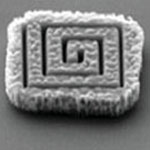 Continuing miniaturization has moved the semiconductor industry well into the nano realm with leading chip manufacturers on their way to CMOS using 22nm process technology. With transistors the size of tens of nanometers, researchers have begun to explore the interface of biology and electronics by integrating nanoelectronic components and living cells. While researchers have already experimented with integrating living cells into semiconductor materials other research is exploring the opposite way, i.e. integrating nanoelectronics into living cells. Researchers in Spain have demonstrated that silicon chips smaller than cells can be produced, collected, and internalized inside living cells by different techniques (lipofection, phagocytosis or microinjection) and, most significantly, they can be used as intracellular sensors.
Continuing miniaturization has moved the semiconductor industry well into the nano realm with leading chip manufacturers on their way to CMOS using 22nm process technology. With transistors the size of tens of nanometers, researchers have begun to explore the interface of biology and electronics by integrating nanoelectronic components and living cells. While researchers have already experimented with integrating living cells into semiconductor materials other research is exploring the opposite way, i.e. integrating nanoelectronics into living cells. Researchers in Spain have demonstrated that silicon chips smaller than cells can be produced, collected, and internalized inside living cells by different techniques (lipofection, phagocytosis or microinjection) and, most significantly, they can be used as intracellular sensors.
Mar 15th, 2010
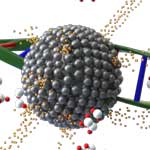 Cancer treatment typically involves chemotherapy, radiotherapy, or surgery, and - depending on the stage of the disease - often is unsuccessful. The most common drawback of all conventional treatments is that they are very imprecise due to a lack of selectivity between malignant and healthy cells. In contrast, nanotechnology offers a vision for a new approach to fighting tumors: the ability of nanoparticle-based techniques to locate cancer cells and destroy them with single-cell precision. Although gold nanoparticles have been very popular with nanomedicine researchers, in a novel approach that combines the sensitizing properties of platinum nanoparticles with hadron therapy (irradiation of tissue by fast carbon ions), a French-Japanese research group has demonstrated that platinum nanoparticles strongly enhance the biological efficiency of radiations.
Cancer treatment typically involves chemotherapy, radiotherapy, or surgery, and - depending on the stage of the disease - often is unsuccessful. The most common drawback of all conventional treatments is that they are very imprecise due to a lack of selectivity between malignant and healthy cells. In contrast, nanotechnology offers a vision for a new approach to fighting tumors: the ability of nanoparticle-based techniques to locate cancer cells and destroy them with single-cell precision. Although gold nanoparticles have been very popular with nanomedicine researchers, in a novel approach that combines the sensitizing properties of platinum nanoparticles with hadron therapy (irradiation of tissue by fast carbon ions), a French-Japanese research group has demonstrated that platinum nanoparticles strongly enhance the biological efficiency of radiations.
Mar 12th, 2010
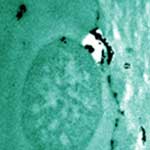 Some scientists believe that, with the increased mass production of engineered nanoparticles like carbon nanotubes, there is a realistic chance for these particles to interact with water, soil and air, and subsequently enter the food chain. However, understanding the behavior and impacts of nanomaterials in the environment and in human health is a daunting task. Nevertheless, a general understanding about nanotoxicity is slowly emerging as the body of research on cytotoxicity, genotoxicity, and ecotoxicity of nanomaterials grows. In our Spotlight today we take a look at new biophysical research - a parallel study of carbon-nanoparticle uptake by plant and mammalian cells - that contributes to the general picture of the fundamental behaviors of nanoparticles in both biological and ecological systems.
Some scientists believe that, with the increased mass production of engineered nanoparticles like carbon nanotubes, there is a realistic chance for these particles to interact with water, soil and air, and subsequently enter the food chain. However, understanding the behavior and impacts of nanomaterials in the environment and in human health is a daunting task. Nevertheless, a general understanding about nanotoxicity is slowly emerging as the body of research on cytotoxicity, genotoxicity, and ecotoxicity of nanomaterials grows. In our Spotlight today we take a look at new biophysical research - a parallel study of carbon-nanoparticle uptake by plant and mammalian cells - that contributes to the general picture of the fundamental behaviors of nanoparticles in both biological and ecological systems.
Mar 10th, 2010
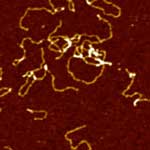 Imaging soft biological samples in liquid with Atomic Force Microscope has long stood as a very challenging task. Until recently, most of the works in this field has been carried out in tapping mode AFM, during which the cantilever driven by a piezoelectric actuator vibrates in the vicinity of the cantilever's resonance frequency, and briefly touches the sample surface at the bottom of each vibration cycle, resulting in a decrease of its oscillation amplitude. By keeping such amplitude at a preset value using feedback control, a topographic image of the sample surface is obtained. However, stable, high-resolution imaging of very fragile and sensitive biological samples such as live cells or individual proteins is not trivial in tapping mode due to potential sample distortion or even damage during the brief contact between the AFM tip and sample surface at the end of each oscillation cycle. The XE-series AFM with Crosstalk Elimination and high force Z-scanner has successfully solved these problems.
Imaging soft biological samples in liquid with Atomic Force Microscope has long stood as a very challenging task. Until recently, most of the works in this field has been carried out in tapping mode AFM, during which the cantilever driven by a piezoelectric actuator vibrates in the vicinity of the cantilever's resonance frequency, and briefly touches the sample surface at the bottom of each vibration cycle, resulting in a decrease of its oscillation amplitude. By keeping such amplitude at a preset value using feedback control, a topographic image of the sample surface is obtained. However, stable, high-resolution imaging of very fragile and sensitive biological samples such as live cells or individual proteins is not trivial in tapping mode due to potential sample distortion or even damage during the brief contact between the AFM tip and sample surface at the end of each oscillation cycle. The XE-series AFM with Crosstalk Elimination and high force Z-scanner has successfully solved these problems.
Mar 9th, 2010
 Freshwater could become the oil of the 21st century - scarce, expensive and fought over. While over 70 per cent of the Earth's surface is covered by water, most of it is unusable for human consumption. Technological advances have made desalination and demineralization feasible - albeit expensive - solutions for increasing the world's supply of freshwater. However, nanotechnology- based water purification devices have the potential to transform the field of desalination. Researchers have now demonstrated a new, efficient and fouling-free desalination process based on the ion concentration polarization (ICP) phenomenon - a fundamental electrochemical transport phenomenon that occurs when an ion current is passed through ion-selective membranes - for direct desalination of sea water.
Freshwater could become the oil of the 21st century - scarce, expensive and fought over. While over 70 per cent of the Earth's surface is covered by water, most of it is unusable for human consumption. Technological advances have made desalination and demineralization feasible - albeit expensive - solutions for increasing the world's supply of freshwater. However, nanotechnology- based water purification devices have the potential to transform the field of desalination. Researchers have now demonstrated a new, efficient and fouling-free desalination process based on the ion concentration polarization (ICP) phenomenon - a fundamental electrochemical transport phenomenon that occurs when an ion current is passed through ion-selective membranes - for direct desalination of sea water. 
 Subscribe to our Nanotechnology Spotlight feed
Subscribe to our Nanotechnology Spotlight feed





